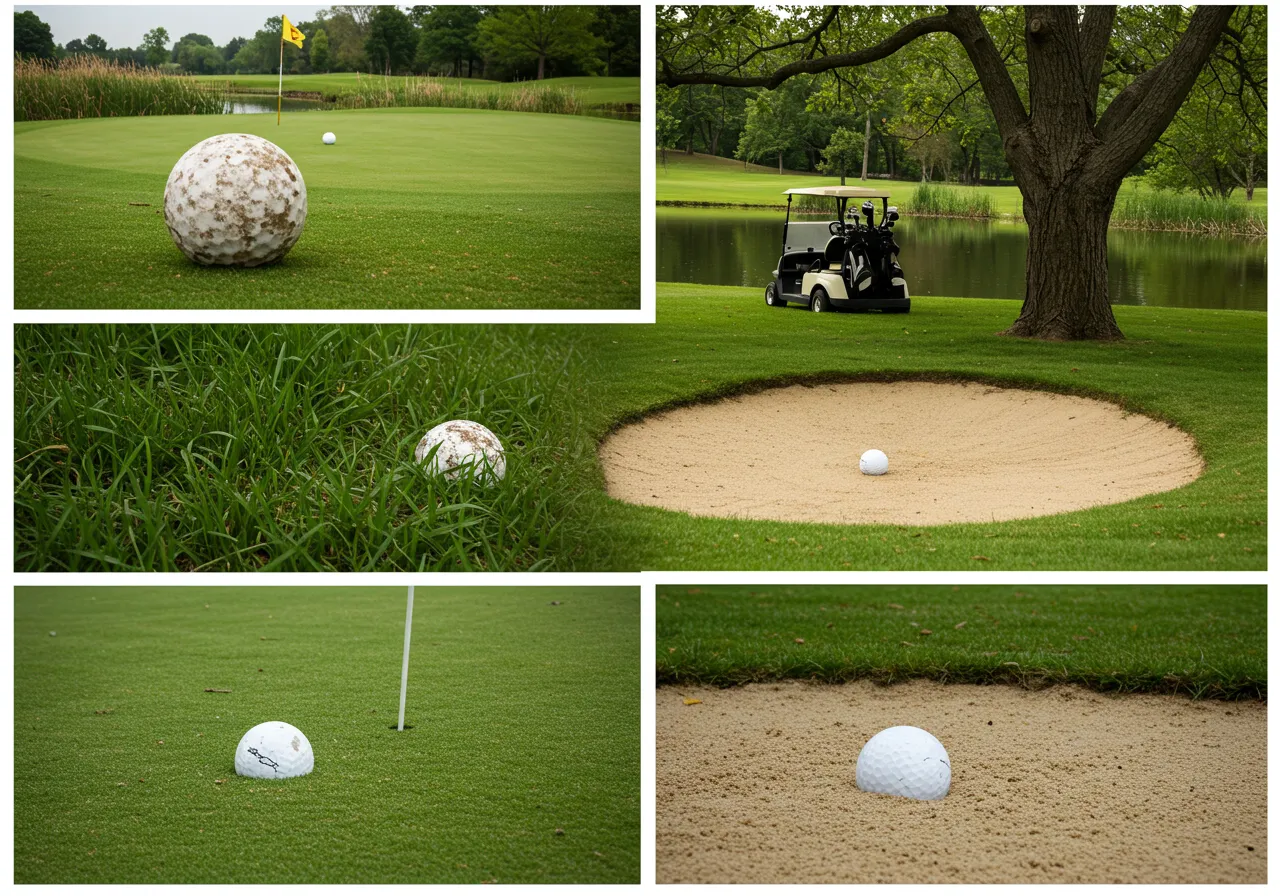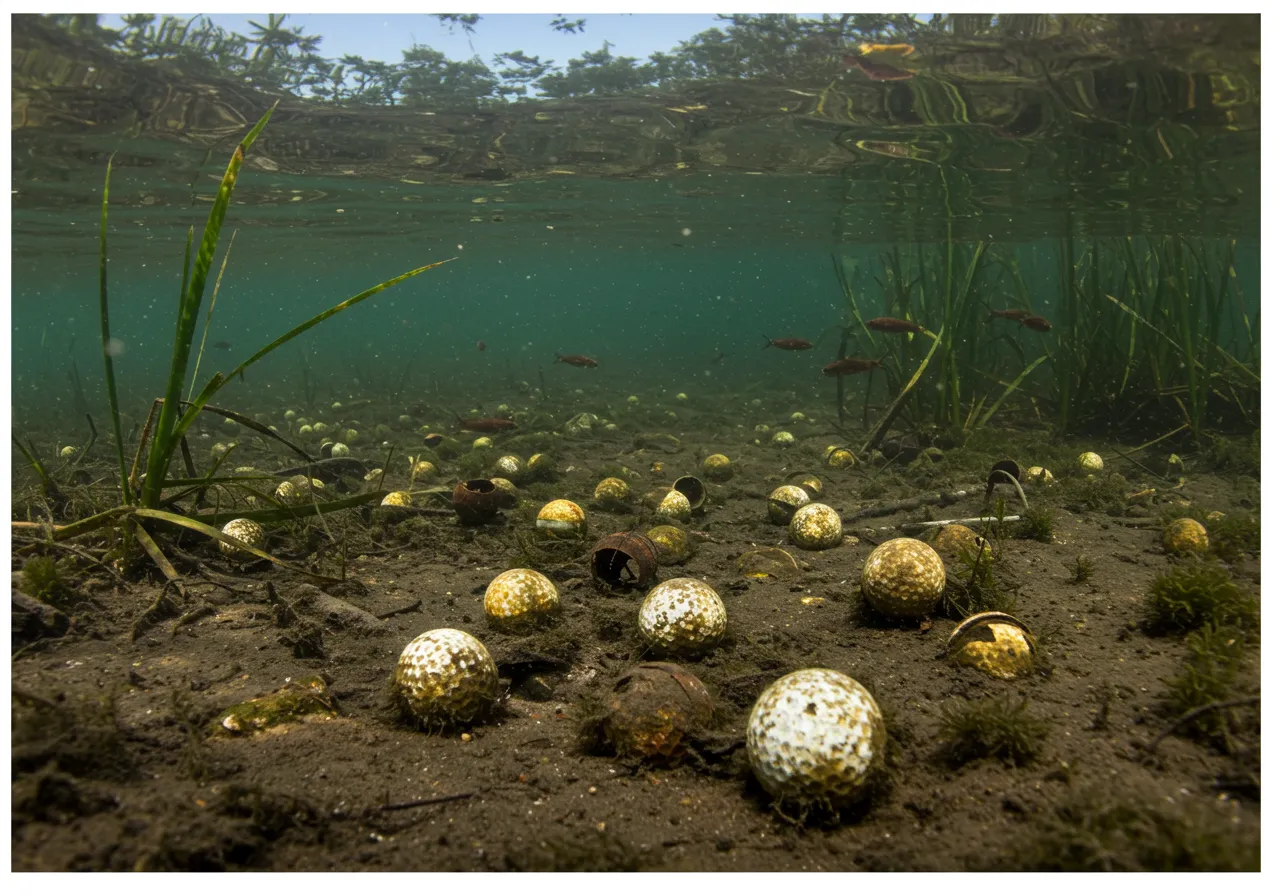How many golf balls are lost each year? A lot more than you might think. Experts say that 3 to 5 billion golf balls are lost around the world every year.
In the United States alone, about 300 million golf balls go missing. These balls often end up in lakes, forests, water hazards, or hidden in the grass where no one finds them.
Losing golf balls isn’t just part of the game; it can also be a big problem for the environment. Most golf balls are not biodegradable, which means they don’t break down easily.
Over time, they can pollute water, harm animals, and add to plastic waste.
Let’s look at where these lost balls go, why it matters, and what we can do about it.
Estimated Golf Balls Lost and Produced Each Year (Global & U.S.)
| Category | Estimated Number | Notes / Source |
| Golf balls lost each year (worldwide) | 3 to 5 billion | Based on estimates from the Danish Golf Union, CNN Environmental Report |
| Golf balls lost per year (USA only) | ~300 million | Reported by the Danish Golf Union, supported by a CNN article and multiple golf blogs |
| Golf balls are produced globally each year | 1.2 to 1.8 billion | Estimated by manufacturers like Titleist, Callaway, and Golf Digest reports |
| Golf balls lost per second (global avg.) | ~5 balls/second | Simple math based on 5 billion/year ÷ 365 days ÷ 24 hours ÷ 60 min ÷ 60 sec |
| Average balls lost per golfer per round | 1–3 balls | Based on amateur play data, Reddit surveys, and golf coaching blogs |
| Biodegradable balls in the market (approx.) | Less than 5% of the total | Small but growing, used mostly in driving ranges near water (source: CNN) |
| Recycled balls resold annually (USA) | ~100 million | From companies like LostGolfBalls.com and Golf Ball Planet |
Note: This table gives a real-world snapshot of how many golf balls are lost, produced, and recycled each year across the globe, especially in the United States.
Why So Many Golf Balls Get Lost Every Year – A Pro Golfer’s Story

Imagine this: every time you blink, 5 golf balls disappear somewhere in the world. That’s not just a fun stat; it really happens.
As a professional golfer, I’ve played on courses all over, and I see it all the time. If the ball goes into the woods, sinks in a water hazard, or vanishes in tall grass, losing golf balls is just part of the game.
In the United States alone, over 300 million golf balls are lost each year. Around the world, that number grows to 3 to 5 billion.
It adds up fast, especially when golfers of all levels are out there every day.
How Many Golf Balls Do Players Lose Each Year
From beginners to pros, everyone loses balls. I’ve seen PGA players lose them just like weekend golfers do. Most of the time, balls are lost in places like:
- Deep forest edges
- Water hazards like ponds and lakes
- Thick, rough, that’s hard to walk through
And once they’re lost, they usually stay lost.
Why Are Lost Golf Balls Bad for the Environment

At first, I didn’t think much about lost balls. But then I learned from studies, like the one shared by CNN, that most golf balls are made from plastic and rubber.
They don’t break down easily. That means they can sit on the ground or in water for hundreds of years.
Some golf balls even leak chemicals, which can hurt animals and pollute rivers or lakes. So the more we lose, the more damage we might be doing to nature without knowing it.
Are There Eco-Friendly Solutions to Lost Golf Balls
Yes, and that’s the good news. Some companies now make biodegradable golf balls that break down over time, great for practice near water.
There are also golf ball recycling companies that collect, clean, and resell used balls.
As a pro, I now try to use recycled or eco-friendly balls when I can. It’s a small change that can help the planet long-term.
How You Can Lose Fewer Golf Balls and Help the Planet
- Avoid risky shots near water when possible
- Use recycled or biodegradable golf balls
- Don’t leave old balls on the course
- Ask your golf course about ball collection or recycling programs
The Real Numbers Behind How Many Golf Balls Are Lost Each Year

As a pro golfer, I’ve played thousands of rounds, and I’ve lost my fair share of balls. But even I was shocked by the actual numbers.
We’re not talking thousands, not even millions, but billions of golf balls lost every single year.
Let’s look at the facts.
How Many Golf Balls Are Lost Each Year in the World
Experts say that over 2 to 3 billion golf balls are lost around the world every year. That’s like dumping a mountain of plastic into nature every year.
These estimates come from industry reports and golf associations in the U.S. and Europe.
From water hazards and deep roughs to forest edges, golf balls are scattered all over the planet. And because they’re not biodegradable, they stick around for a long, long time.
How Many Golf Balls Are Lost Each Year in the USA
In the United States, we lose an estimated 300 to 450 million golf balls every year.
That number comes from real data:
- The National Golf Foundation says around 441 million rounds are played in the U.S. annually.
- The average golfer loses about 1.2 balls per round.
Do the math, and it makes sense—hundreds of millions of balls disappear on American courses alone.
How Many Golf Balls Are Lost Every Day Around the World

If you break it down by day, the numbers get even wilder:
- In the U.S., between 820,000 and 1.2 million golf balls are lost every single day.
- Globally, it’s between 5.5 million and 8.2 million golf balls lost daily.
Just think about that next time you step on a tee box, millions of balls are getting lost while we play.
Comparison Table: Golf Balls Lost Per Year, Per Day, and Per Golfer
Here’s a simple chart I always show young players when they ask, “Is losing a ball a big deal?”
Yes, it is, because when millions of golfers lose even a few each week, it adds up fast.
| Region | Annual Losses | Daily Losses | Per Golfer / Year |
| USA | 300M–450M | 820K–1.2M | 12–18 balls |
| Global | 2B–3B+ | 5.5M–8.2M | 8–12 balls |
What This Means for Golf and the Environment
These numbers are not just about lost strokes or extra spending, they’re about the environment.
Golf balls that get left in lakes, woods, or oceans don’t break down. They can leak chemicals and add to plastic pollution.
That’s why I now encourage golfers to:
- Play smarter to avoid losing balls
- Try recycled or biodegradable golf balls
- Support golf courses with ball recovery or recycling programs
Why So Many Golf Balls Go Missing on the Golf Course

If you’ve ever played a round and ended up with fewer balls in your bag than you started with, you’re not alone.
As someone who’s played golf for years, I can tell you: losing golf balls is super common, especially for newer players. But even pros like me aren’t perfect.
How Many Golf Balls Does the Average Golfer Lose Each Round
Most golfers lose about 1 to 3 golf balls per round. That’s not a guess; it comes from surveys on Reddit, PGA teaching pros, and golf course data.
If you’re new to the game or playing a tough course, you’ll likely lose more. Things like:
- Course difficulty
- Water hazards and thick rough
- Wind or slope
- And even just a bad swing
Can you all send your ball somewhere it won’t come back from.
How Often Do Professional Golfers Lose Balls
You might think pros never lose a ball, but they do! We just lose them way less often. Most PGA Tour players lose about 0.2 to 0.5 balls per round. That’s maybe 1 ball every 2 to 5 rounds.
Why the big difference?
- We know where the danger spots are
- We play safer shots
- And we have better control under pressure
Still, I’ve had days when I lost a couple on a windy course.
Where Do Most Golf Balls End Up When Lost

According to a Golf Digest survey, here’s where those lost golf balls usually go:
- Water hazards: 61% (That’s the biggest!)
- Tall, rough, or deep grass: 29%
- Woods and trees: 10%
So if you’re playing near a pond or river, keep your shots straight or bring extras!
Are Golf Balls Easy to Lose During a Game
Yes, golf balls are very easy to lose, especially if you’re just learning. A study from GetStartedGolfing found that about 65% of amateur golfers lose at least one ball every round.
Sometimes, even a good shot can roll off the fairway and vanish in tall grass. And once it’s gone? You’ve got 3 minutes to find it, according to golf rules, after that, it’s considered lost.
Table: How Many Golf Balls Golfers Lose and Where They Go
| Category | Details | Source / Notes |
| Average golf balls lost (amateur golfer) | 1.2 – 3 balls per round | Reddit surveys, PGA coach estimates |
| Average golf balls lost (pro golfer) | 0.2 – 0.5 balls per round | PGA Tour data |
| Percent of lost balls in water hazards | 61% | Golf Digest survey |
| Percent of lost balls in tall rough | 29% | Golf Digest |
| Percent of lost balls in the woods | 10% | Golf Digest |
| Percent of amateur golfers losing 1+ balls/round | 65% | GetStartedGolfing.com |
| Time limit to find a lost golf ball | 3 minutes | USGA rule for ball search |
Note: This chart gives a simple overview of how many golf balls are typically lost by both casual and professional golfers, and where most of those balls end up.
What Happens to Lost Golf Balls in Lakes and Oceans

As someone who’s played on courses near oceans, rivers, and lakes, I’ve seen dozens of balls disappear into the water, mine included.
At first, I thought they just stayed down there and did no harm. But I was wrong.
Do Golf Balls Pollute Water When They Are Lost
Yes, they do. Most golf balls are made with plastic covers and rubber cores that never break down naturally.
When they sit underwater for years, they start to break apart slowly and release harmful stuff, like:
- Microplastics
- Zinc
- Lead
According to a study by Stanford University, these materials can leak into the ocean or lake water for 100 to 1,000 years.
One diver in a CNN story found thousands of old golf balls on the ocean floor, some already breaking apart.
So, even though they’re small, lost golf balls are real litter, especially when millions of them sink underwater.
Are Golf Balls a Form of Litter or Pollution
Yes, absolutely. Because golf balls are not biodegradable, they become part of the plastic waste problem.
Just like plastic bottles or bags, golf balls pollute nature when left behind.
Most people don’t see them once they’re lost in the woods or underwater, but they’re still there. They don’t disappear.
That’s why many courses today are trying to clean up old balls and educate players.
Can Biodegradable Golf Balls Help the Environment

Yes, and I’ve tried a few of them. Some of the new eco-friendly golf balls, like:
- ECCO Biodegradable Balls
- David Leadbetter’s Eco-Ball
- Tomorrow Golf Balls (made from plant-based materials)
It can break down naturally in 2 to 3 years, which is way better than a thousand.
They’re perfect for practice near water, like on cruise ships, beachside driving ranges, or training areas near lakes.
But there’s a downside: right now, these eco-golf balls aren’t good enough for pro-level play. They don’t feel or fly like regular tour balls.
Still, they’re a great step forward for casual practice or beginners.
What I Tell Golfers Today About Lost Balls and the Planet
As a pro, I now think more about how golf affects the environment. Golf is an outdoor sport, and we should protect the places we play.
I always suggest:
- Don’t hit balls into lakes or oceans for fun
- Use biodegradable practice balls when training near water
- Support courses that recycle or clean up lost balls
One small choice, like switching to eco-friendly balls for practice, can make a big difference over time.
Who Recycles Lost Golf Balls and How It’s Helping the Game
After seeing how many balls get lost each year, and knowing how bad it is for the planet, I started learning more about golf ball recycling. The good news?
There are smart companies out there that actually collect, clean, and reuse millions of balls every year.
What Golf Ball Recycling Companies Recover Lost Balls

The biggest player in the game is LostGolfBalls.com. They collect and recycle over 20 million used balls every year.
I’ve used their recycled balls in practice; they feel great and cost less.
Other recovery teams include:
- Eco Golf in the UK – they even send divers into the ocean to recover sunken balls
- Local course partnerships, some golf courses hire companies to recover balls from ponds and sell them back
These efforts keep plastic waste out of nature and help golfers save money.
Is It Legal to Collect Lost Golf Balls from Golf Courses
This is something every golfer should know: you can’t just walk onto a golf course and pick up balls without permission.
Even if you find them in the woods or water, they still belong to the course.
Without approval, it’s considered trespassing. Some states and countries have strict laws. I’ve known a few folks who got in trouble for diving into ponds without asking.
If you want to collect balls legally:
- Get permission from the course
- Or work with a licensed golf ball recovery company
That way, it’s safe, legal, and helps everyone.
How Long Do You Have to Find a Lost Golf Ball During a Round
According to Rule 18.2a of the golf rulebook, you get exactly 3 minutes to look for your ball once you start searching.
If you don’t find it in that time, it’s considered lost, and you have to take a penalty.
I always tell younger players to stay calm, walk slowly, and check the rough carefully, but don’t waste time.
What I Recommend to Young Golfers
- Support courses and companies that recycle balls
- Use recycled or refurbished balls for practice
- Never collect balls from private land without permission
- Learn the rules, especially the 3-minute search limit
Golf is a game of honor. That means doing your part, not just on the scorecard, but for the environment too.
How to Avoid Losing Golf Balls – Pro Tips That Work on Any Course

I’ve lost more golf balls than I can count, especially in my early days. But over time, I learned some simple tricks that help golfers keep more balls in play. If you’re just starting or aiming to get better, here are my top tips.
Use Bright Colored Golf Balls to Make Them Easier to Find
One of the easiest ways to lose fewer balls is to switch from white to bright, matte-colored golf balls.
Colors like yellow, orange, or neon green are much easier to spot in grass, sand, or shade.
According to a test by GolfWRX, these balls are 27% easier to find compared to regular white balls. I use yellow or matte orange in cloudy weather, as they stand out more.
Club Down Near Water Hazards or Trouble Spots
When you’re playing near a lake or deep rough, I always suggest “club down” which means using a shorter club with more control.
Why? Because going for distance often causes hooks or slices, especially for newer golfers.
Using a safer club can reduce bad shots by up to 40%, especially near hazards.
I’d rather be short and safe than long and lost.
Hit a Provisional Ball If You Think It Might Be Lost
If you hit a shot and you’re not sure where it landed, don’t wait, just hit a provisional ball.
Under Rule 18.3, this saves time and avoids walking back if your first shot is lost. As a pro, I still do this when I hit blind spots or near thick trees.
It’s better to be safe than sorry, and it keeps the game moving.
Avoid Low-Quality Refurbished Golf Balls
While recycled balls are great for the planet, not all of them are the same. Some refurbished balls can have hidden cracks or defects that make them fly funny.
I’ve tested balls that looked brand new but flew 20 yards off target.
If you’re serious about your round, stick with AAA or mint-grade used balls, or new ones when it counts.
Try Golf Ball Trackers or GPS Tools to Locate Shots
![]()
If you play often or tend to slice into rough, golf ball tracking tools can help.
Devices like Shot Scope or Arccos GPS sensors can track where you hit your shots, and some even log your average misses.
I’ve used these during practice rounds to see my shot patterns and make better choices. It’s like having a digital caddie.
Table: How to Avoid Losing Golf Balls – Pro Golfer Tips with Real Data
| Tip | What It Means | Why It Works | Data / Source |
| Use brightly colored matte golf balls | Play with yellow, orange, or green balls instead of white | Easier to see in grass, rough, or sand | GolfWRX: 27% easier to spot |
| Club down near hazards | Use a shorter, safer club when hitting near water or trees | Reduces the chances of slicing or hooking | Reduces mishits by 40% (swing coach data) |
| Hit a provisional ball (Rule 18.3) | If you think your shot is lost, hit another ball right away | Saves time, avoids a stroke penalty later | USGA Rule 18.3 |
| Avoid low-quality refurbished balls | Don’t use heavily worn or cracked balls | Defective balls can fly off-target | Higher defect rate in low-grade used balls |
| Use GPS or golf ball tracking tools | Devices like Shot Scope help track shot direction and landing spots | Helps recover more balls and improve course management | Tech reviews and PGA practice rounds |
Note: This table gives five easy and proven ways to avoid losing golf balls on the course. Each tip is backed by real data or pro experience.
FAQs
How Many Golf Balls Are Made Each Year Around the World?
More than 1.2 billion golf balls are made every year. That’s enough to give every person on Earth a ball, and still have extras!
Titleist, one of the biggest brands, makes over 300 million balls by itself.
Do Golf Balls Lose Distance or Go Bad Over Time?
Yes, they do. After 7 to 10 years, the inside core of a ball starts to harden. That means it won’t fly as far, usually 5 to 10 yards shorter than a new ball.
I always tell players: if your ball is really old or has been in water, it’s best to replace it for better performance.
How Many People Get Hit by Golf Balls Every Year?
About 40,000 people in the United States go to the emergency room each year after being hit by a golf ball.
That’s why it’s so important to shout “Fore!” if your ball is heading toward someone. I’ve done it dozens of times, and it really helps prevent accidents.
How Many Golf Clubs Are Lost Each Year on the Course?
There’s no exact number, but a survey from Golf Monthly said that around 4% of golfers admit to leaving a club behind during a round.
I’ve found several clubs left on the green or near a tee box myself. So I always remind young players: double-check your bag before walking off!
How Many Golf Balls Get Lost Every Year?
Worldwide, golfers lose between 2 and 3 billion golf balls every year. That includes balls lost in lakes, forests, and rough terrain. In the U.S. alone, it’s about 300 to 450 million balls per year.
How Often Do Pro Golfers Lose Golf Balls?
As a pro, I usually lose very few, maybe 1 ball every 2 to 5 rounds. The PGA Tour average is between 0.2 and 0.5 lost balls per round.
Even at the highest level, a bad swing or tough course can still cause a lost ball. We just make it happen less often with experience.
How Many Golf Balls Does the Average Golfer Lose Per Round?
The average amateur golfer loses about 1 to 3 balls every round. That depends on the course, skill level, and weather.
I’ve coached players who started losing 5 per round, but after a few lessons, they dropped to 1 or none!
Are Golf Balls Easy to Lose on the Course?
Yes, especially for new golfers. Balls can roll into:
- Tall grass
- Water hazards
- Under bushes or trees
About 65% of casual golfers lose at least one ball every time they play. That’s why it’s good to carry a few extra and know how to avoid high-risk shots.
Conclusion
Most golf balls today are made to last, but that’s also the issue. They’re not biodegradable, and when they break down, they release microplastics and heavy metals that harm nature.
We need more brands to create eco-friendly golf balls that can break down naturally in a few years, not centuries.
And we need more golf courses and players to support recycling programs that collect and clean lost balls.
Golf is a sport that brings people outside. We enjoy clean air, green grass, and open skies. So let’s do our part to keep it that way.
Play smart, play clean, and remember, every ball saved helps the planet a little bit more.
I Found Thousands Of Lost Golf Balls in the Bushes
Posts References:
How many golf balls are lost every year in the US
Golf Balls as Pollution